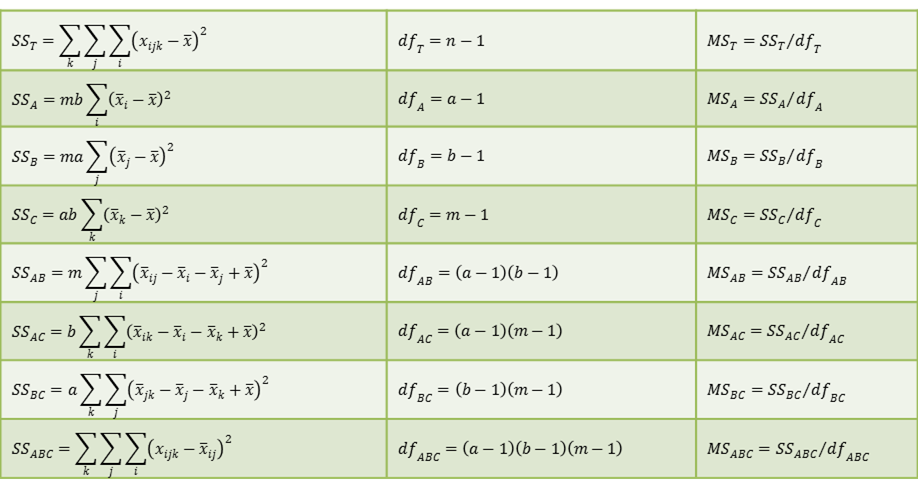We now describe the structural model for repeated measures ANOVA where there are two within-subjects factors.
Definitions
Definition 1: We modify the structural model of Definition 1 of Two Factor ANOVA with Replication as follows. Note that we will use a to indicate the number of levels for factor A (instead of r) and b to indicate the number of levels for factor B (instead of c). Also, m = the number of subjects or participants.
We use terms such as x̄i (or x̄i.) as an abbreviation for the mean of {xijk: 1 ≤ j ≤ b, 1 ≤ k ≤ m}. We also use terms such as x̄j (or x̄.j) as an abbreviation for the mean of {xijk: 1 ≤ i ≤ a, 1 ≤ k ≤ m}.
We define the effects αi and βj where
Similarly, we define ai and bj where
We use δij for the effect of level i of factor A with level j of factor B, i.e. the interaction of level i of factor A and level j of factor B. Thus, δij = μij – μi – μj + μ. Similarly, we have
It is easy to show that
Finally, we can represent each element in the sample as
where εijk denotes the error (or unexplained) amount, where
and γk is a random effect corresponding to the subjects/participants. All the interaction terms, i.e. (αγ)ik, (αβ)jk, and (αβγ)ijk, are also random effects; together they make up the error components of our model.
As before we have the sample version
where eijk is the counterpart to εijk in the sample. The null hypotheses for main effects are:
H0: µ1. = µ2. = ··· µa.(Factor A)
H0: µ.1 = µ.2 = ··· µ.b(Factor B)
These are equivalent to:
H0: αi = 0 for all i (Factor A)
H0: βj = 0 for all j (Factor B)
In addition, there is a null hypothesis for the effects due to the interaction between factors A and B.
H0: δij = 0 for all i, j
Definition 2: Using the terminology from Definition 1 of Two Factor ANOVA with Replication, except that we use a for the number of levels in factor A (instead of r) and b for the number of levels in factor B (instead of c), and also adding C = the participant factor and m = number of participants, define:
We can also define four types of between-group terms.
And similarly for BetAC and BetBC. There is also the following BetABC version:
![]()
![]()
![]()
Properties
Property 1:
![]()
Proof: It is clear that
![]()
If we square both sides of the equation, sum over i, j, and k and then simplify (with various terms equal to zero as in the proof of Property 2 of Basic Concepts of ANOVA), we get the first result. The second result is trivial.
Property 2: If a sample is made as described in Definition 1 of Basic Concepts of ANOVA, with the xijk independently and normally distributed and with all (or
) equal, then
Proof: The proof is similar to that of Property 1 of Basic Concepts of ANOVA.
Theorem 1: Suppose a sample is made as described in Definitions 1 and 2 of Two Factor ANOVA with Replication, with the xijk independently and normally distributed.
If all μi are equal and all are equal then
If all μj are equal and all are equal then
Also, under certain circumstances,
Proof: The result follows from Properties 1 and 3 of F Distribution.
Property 3:
![]()
![]()
![]()
We use the following tests:
If the null hypothesis for factor A is true, then = 0, and so
whereas if the null hypothesis is not true then > 1. The results are similar for the other null hypotheses.
Reference
Howell, D. C. (2010) Statistical methods for psychology (7th ed.). Wadsworth, Cengage Learning.
https://labs.la.utexas.edu/gilden/files/2016/05/Statistics-Text.pdf


